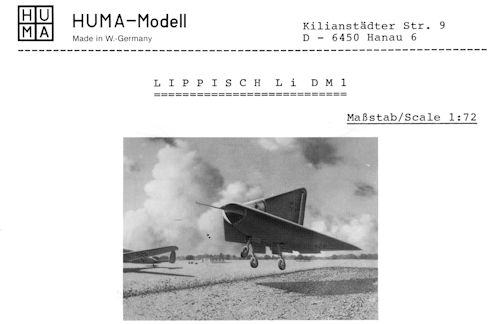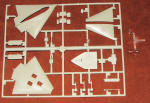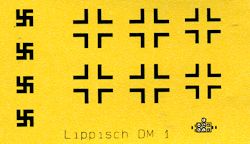
Huma Model 1/72 Lippisch DM-1
| KIT #: | HM0021 |
| PRICE: | $ |
| DECALS: | one option |
| REVIEWER: | Scott Van Aken |
| NOTES: | Short run kit |

| HISTORY |
The DM-series was a joint project of the Darmstadt and Munich Akafliegs. During planning all limits were set aside and, what may seem impossible today was seriously studied, such as the DM4 with a planned wing area of 70m2 (753.5 sq.ft.) expected to reach speeds of 16000 km/h (10,000 mph).
During World War II Dr. Alexander Lippisch proposed a ramjet propelled point defence fighter Lippisch P.13a. To investigate the low speed handling and aerodynamics of this delta-winged fighter, Lippisch arranged for Akaflieg Darmstadt to build a full-scale flying glider model, which emerged as the Darmstadt D-33. After the Akaflieg Darmstadt workshop was bombed in September 1944, the D-33 project was moved to the Akaflieg München workshops at Prien am Chiemsee. At Prien, Wolfgang Heinemann and Hans Zacher from Darmstadt, with Klaus Metzner and Hermann Nenninger from Munich, completed the D-33 as the Akaflieg Darmstadt/Akaflieg München DM1.
Film footage exists which shows a gliding test of the aircraft. These tests began in May 1944 at Spitzerberg, near Vienna.
The DM1 was built as a single-seat glider from steel-tubing, plywood and bakelite impregnated plywood, with a cockpit in the extreme nose of the junction of the triangular mainplanes and fin. Launching the DM1 was to be by piggy-back or aero-tow.
After liberation by U.S. Troops in May 1945, work continued at the DM1 on behalf of the U.S. military government, with General Patton and Charles Lindbergh visiting Prien to see the project. Completed in early November 1945, the DM1 was shipped in a wooden box to Langley Field in Virginia where the flow behavior of the DM1 was examined in the NACA (National Advisory Committee for Aeronautics, forerunner of today's NASA) full-size wind tunnel.
The Delta-glider influenced design of the Convair delta fighters such as XP-92, XF-92A, XFY, F2Y, F-102 and F-106, though these were very different, thin wing deltas. After completion of testing the DM1 was retired to the National Air and Space Museum, Smithsonian Institution in Washington, D.C. for storage at the Paul E. Garber Preservation, Restoration, and Storage Facility.
| THE KIT |
 For those who are unaware, Huma used to produce some superlative short run
kits of German aircraft. Some were only done by Huma and still have not been
duplicated by other manufacturers, though it does seem that RS and AZ model are
slowly making inroads into this area. For those who are unaware, Huma went bust
in mid 2010. Allegedly a distributor bought a huge shipment of kits and then
refused to make payment for them and declared bankruptcy. This left Huma with
pretty much no cash flow to pay bills and the result was cessation of business. They will be
missed.
For those who are unaware, Huma used to produce some superlative short run
kits of German aircraft. Some were only done by Huma and still have not been
duplicated by other manufacturers, though it does seem that RS and AZ model are
slowly making inroads into this area. For those who are unaware, Huma went bust
in mid 2010. Allegedly a distributor bought a huge shipment of kits and then
refused to make payment for them and declared bankruptcy. This left Huma with
pretty much no cash flow to pay bills and the result was cessation of business. They will be
missed.
This is one of their earlier kits in that it did not come in a box. It is not one of their earliest kits, which were a soft, white plastic, but one a bit later in the greyish plastic that is a bit harder. There are ejector pin marks on just about every part and the sprue attachment point continues a small distance onto the surface of the part itself in many instances. This is a very simple kit that consists of a single grey plastic sprue and one that is clear.
The fuselage/tail is two parts with the wing assembly also being two. There is a slab interior with a bulkhead. Other interior bits consist of a seat that sits on a pedestal, rudder pedals and control stick. The instrument panel is blank and one uses a decal for instruments. No sidewalls. There are also no real wheel wells with the bottom of the interior floor having holes to accept the three gear legs. Each gear leg has the wheel molded in place. The gear doors will need to have the ejector pin sanded off prior to use. A long probe is included for the nose. Ailerons and the rudder are separate pieces.
 The instructions are a single large, folded sheet. One side has a history in
German, on the back is a history in English and French. Opening the sheet you
have a three view with color information and on the other is an exploded
view showing all the parts. There is no interior color information and
apparently the outside of the aircraft was left in a plywood finish. Though
never carried, a set of insignia is provided.
The instructions are a single large, folded sheet. One side has a history in
German, on the back is a history in English and French. Opening the sheet you
have a three view with color information and on the other is an exploded
view showing all the parts. There is no interior color information and
apparently the outside of the aircraft was left in a plywood finish. Though
never carried, a set of insignia is provided.
| CONCLUSIONS |
Though Huma is out of business, their kits can still be found. While not the most complex kit around, this one is important because of its influence on Convair and others post war.
| REFERENCES |
http://en.wikipedia.org/wiki/Lippisch_DM-1
November 2013 Thanks to me for providing the preview kit.
If you would like your product reviewed fairly and fairly quickly, please
contact
the editor
or see other details in the
Note to
Contributors.